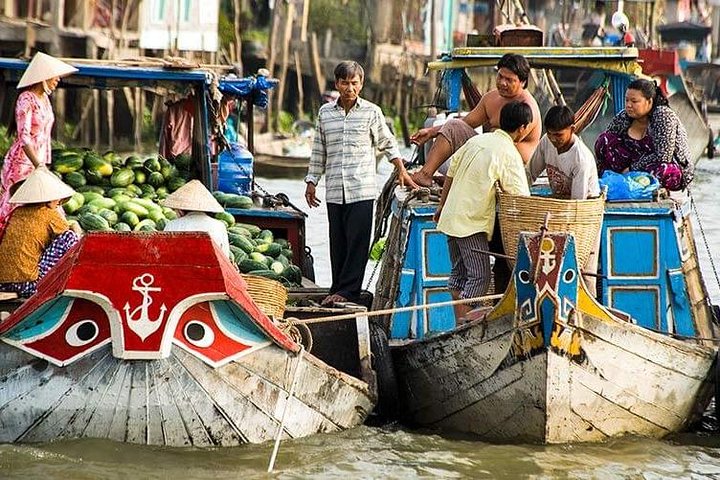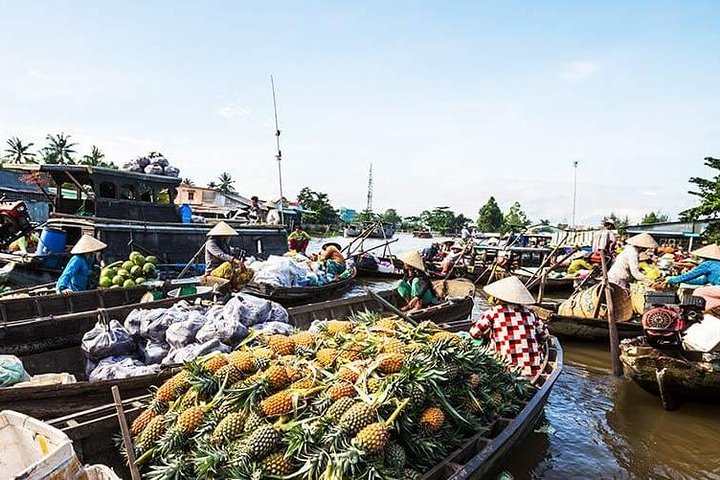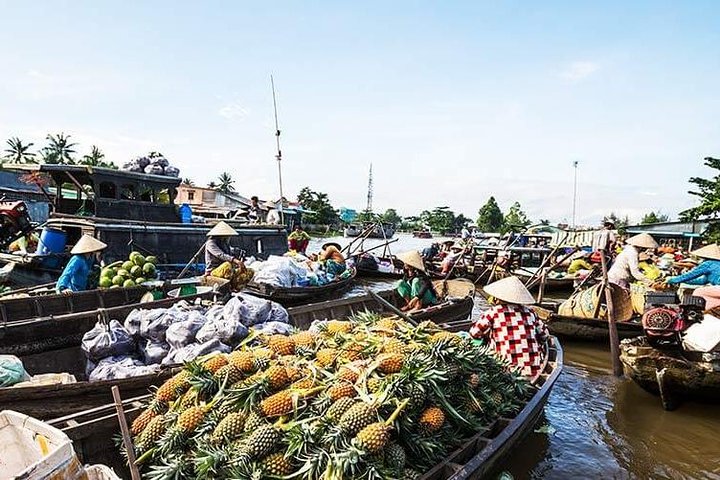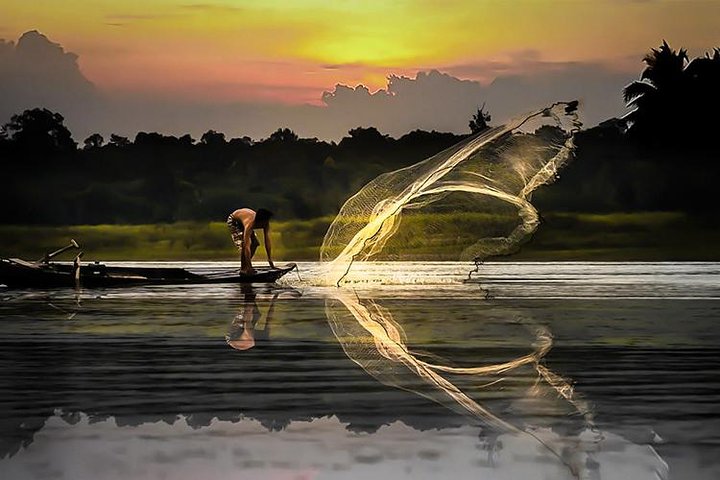Embark on a luxury group tour in Ho Chi Minh City and explore historic sites, learn traditional crafts, visit museums, admire colonial architecture, and immerse yourself in the lively local atmosphere.
Embark on a luxury group tour in Ho Chi Minh City and explore historic sites, learn traditional crafts, visit museums, admire colonial architecture, and immerse yourself in the lively local atmosphere.
- Saigon Opera House (Ho Chi Minh Municipal Theater) - The Saigon Opera House, also known as the Municipal Theater, stands proudly in the heart of Saigon. It is a remarkable sight both day and night. Constructed in 1898 by French architect Eugene Ferret, it showcases the “flamboyant” style of the French Third Republic. Elevated two meters above…
-
Saigon Opera House (Ho Chi Minh Municipal Theater) - The Saigon Opera House, also known as the Municipal Theater, stands proudly in the heart of Saigon. It is a remarkable sight both day and night. Constructed in 1898 by French architect Eugene Ferret, it showcases the “flamboyant” style of the French Third Republic. Elevated two meters above street level with double doors, it effectively blocks traffic noise.
Located on the city’s central axis, it connects the metro station and the roundabout in front of Ben Thanh market. From afar, the Opera House resembles a grand city gate. Its architecture features stone-carved ornaments and statues at the entrance, crystal chandeliers, and a gleaming granite floor in the lobby, all crafted with materials imported from France. The elegant oval auditorium, with 468 seats, is designed to enhance performances both visually and acoustically, while being soundproof from the city’s hustle and bustle. -
Reunification Palace, HCMC, Vietnam - Encircled by royal palm trees, this landmark government building’s 1960s architecture and the eerie atmosphere of its empty halls make it a fascinating sight. The first Communist tanks arrived here on April 30, 1975, and it feels as though time has stood still since then. The building is closely linked to the city’s fall in 1975, yet its kitschy details and period motifs are captivating. Also known as the Independence Palace, it was home to South Vietnamese President Nguyen Van Thieu until his hurried departure in 1975. Designed by Paris-trained Vietnamese architect Ngo Viet Thu, it exemplifies 1960s architecture with an open and airy feel.
The Reunification Palace, also called Independence Palace, is a significant landmark in the heart of Ho Chi Minh City and is a must-see national monument when visiting the city. -
Central Post Office - This iconic French-era post office is a classic of its time, designed by Marie-Alfred Foulhoux (though often attributed to Gustave Eiffel) and constructed between 1886 and 1891. A mosaic of Ho Chi Minh is prominently displayed at the end of its barrel-vaulted hall.
The post office boasts a distinctive bright yellow exterior with white trim. Its curved windows are elegantly framed with green shutters, and a large clock is prominently featured at the main entrance. The stunning, spacious interior features tall, domed ceilings with metal arches and a beautiful patterned tile floor. Inside, there are two painted maps: “Lignes télégraphiques du Sud Vietnam et du Cambodge 1892” (Telegraphic lines of southern Vietnam and Cambodia 1892) shows the postal route from southern Vietnam to Cambodia, and “Saigon et ses environs, 1892” (Saigon and its surroundings) is a local map. -
Emperor Jade Pagoda - Built in 1909 to honor the supreme Jade Emperor (King of Heaven), this is one of the most atmospheric temples in Ho Chi Minh City, filled with statues of mystical divinities and heroic figures.
The air is thick with the scent of incense, obscuring the intricate woodcarvings. The roof is adorned with elaborate tile work, and the temple’s statues, depicting characters from both Buddhist and Taoist traditions, are crafted from reinforced papier-mâché.
The temple’s multifaith nature is reflected in its alternative name, Phuoc Hai Tu, which conveys a Buddhist message. Similarly, the Chinese characters in the main temple hall mean ‘The light of Buddha shines on all.’
Over a century has passed with many changes, yet the Jade Emperor Pagoda retains its timeless charm. Its beauty is a harmonious blend of the three main religions of the Orient: Taoism, Buddhism, and Confucianism.
Thanks to its impressive and unique beauty, along with its sacred legend, this is one of the most wonderful destinations. -
Sơn mài Đại Việt - Lacquer is actually the resin of a tree mixed with colored pigments and solvents, applied layer by layer to an object’s surface, creating a shiny and durable finish. Eggshell and mother of pearl may be added before the lacquer is applied, and the finished product is sanded to reveal the decoration beneath.
The high-quality resin from Vietnamese lacquer trees, especially those in Phu Tho, was crucial to the rapid development of this art form during the feudal period. Decorated lacquer statues, panels, boxes, and trays (1428-1527) can still be seen in many temples and pagodas.
In later centuries, lacquerware was used for larger items like wooden chairs and tables. Since then, lacquerware has become a staple of the Vietnamese handicraft industry, both domestically and internationally. Today’s most popular items include vases, jewel cases, desk sets, trays, and vertical blinds. -
War Remnants Museum - Established on September 4, 1975, the War Remnants Museum is a member of the International Network of Museums for Peace (INMP) and the International Council of Museums (ICOM).
It is the only museum in Vietnam dedicated to systematically studying, collecting, conserving, and displaying exhibits on war crimes and the consequences inflicted on the Vietnamese people by foreign aggressors. The museum also advocates for peace, friendship, and solidarity among nations.
The museum features nine permanent thematic exhibitions and various special collections. Throughout the year, it hosts a wide range of activities, including conferences, meetings with war witnesses, and temporary and traveling exhibitions. With nearly one million domestic and international visitors annually, the War Remnants Museum is one of Ho Chi Minh City’s most captivating cultural and tourist attractions.

- Travel insurance coverage up to $5,000 USD
- Complimentary bottled water
- Guided tour with an English-speaking guide
- All entrance fees included
- Air-conditioned transportation
- 24/7 hotline support
- Travel insurance coverage up to $5,000 USD
- Complimentary bottled water
- Guided tour with an English-speaking guide
- All entrance fees included
- Air-conditioned transportation
- 24/7 hotline support
- Tips/ gratuities
- Personal expenses
- Tips/ gratuities
- Personal expenses
• Museum of War Relics
• Explore the colonial designs of Notre Dame Cathedral
• Historic cultural landmarks of Ho Chi Minh City
• In-depth tour of the ancient Reunification Palace
• Journey to the historic General Post Office from the 18th century
• Experience the bustling environment of the local marketplace and venture into hidden alleys
• Tour of a…
• Museum of War Relics
• Explore the colonial designs of Notre Dame Cathedral
• Historic cultural landmarks of Ho Chi Minh City
• In-depth tour of the ancient Reunification Palace
• Journey to the historic General Post Office from the 18th century
• Experience the bustling environment of the local marketplace and venture into hidden alleys
• Tour of a classic assortment of military gear
• Discover the process of crafting traditional Vietnamese lacquerware artworks
• Take in the architectural grandeur of the Colonial-era
For a full refund, cancel at least 24 hours before the scheduled departure time.
For a full refund, cancel at least 24 hours before the scheduled departure time.


















